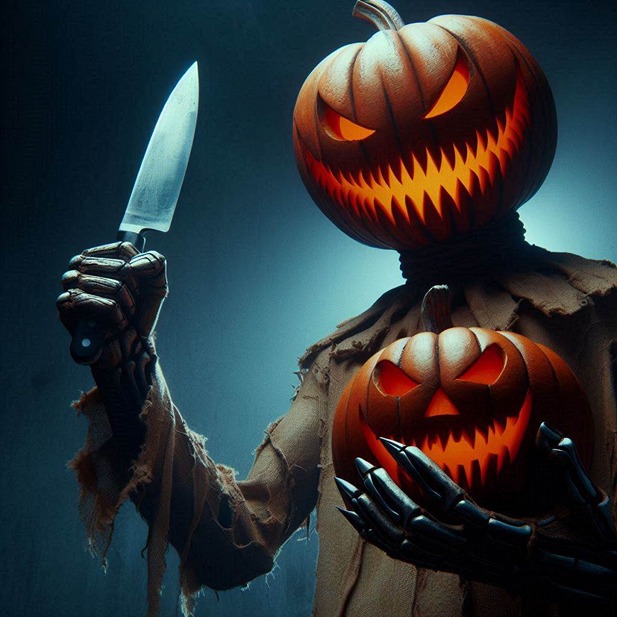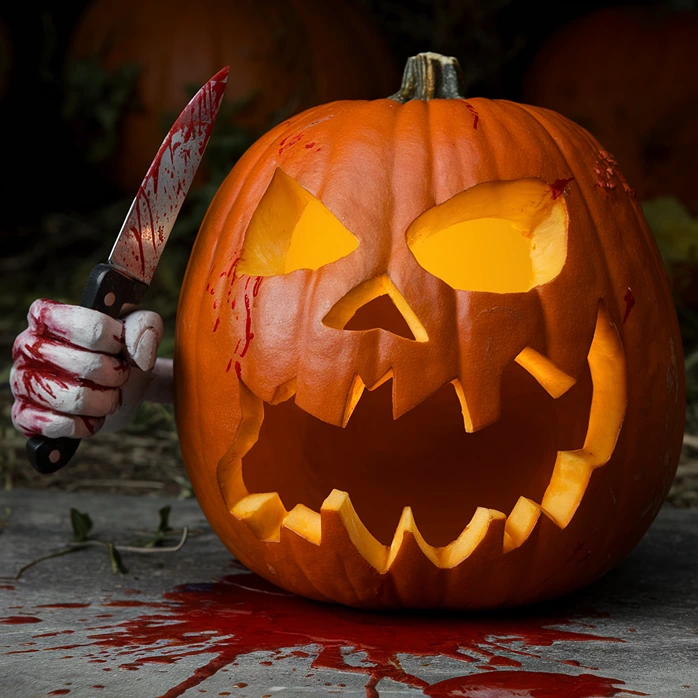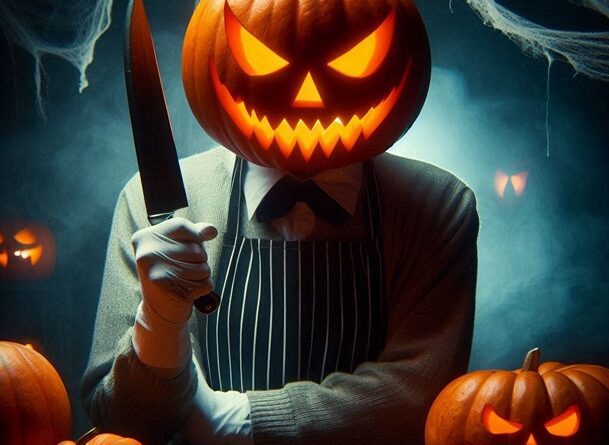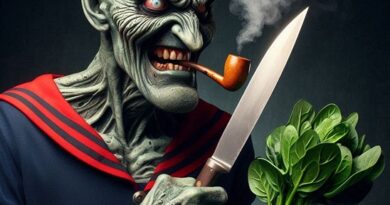Jack O-Lantern: How Did The Carved Pumpkin Become The Symbol Of Halloween?
In almost every Halloween movie, you’ll see them: Pumpkins, of course, which decorate the houses that celebrate the holiday. The twist is that it’s not just a pumpkin but a lantern made from pumpkins – and sometimes other plants – carved into a scary head. It’s called a Jack-o’-Lantern (or Jack O’lantern), and it’s one of the definite signs of Halloween.
Not everyone knows, but behind one of the most distinctive holiday symbols lies an Irish folk legend, and behind this craft (some would say art), there’s a lot of thought. Let’s get to know the famous horror myth, which began in 18th-century Ireland and went from there to Halloween and many related horror films.
What Is A Jack-o’-Lantern?
A Jack-o’-Lantern, as you probably know, is a lantern usually made from a pumpkin but can also be made from other plants such as a turnip or rutabaga (a type of Brassica napus.) The cabbage is hollowed out and carved, usually into a shape that resembles a scary face with a smile that looks like it came out of the “Smile” movie studio. A candle or other lighting device is placed inside the Jack-o’-Lantern, putting the pumpkin in a different, more menacing light.
Today, the Jack-o’-Lantern is usually displayed during Halloween in a prominent place, whether on the porch, in the yard, in the window, on the door, and so on. In addition to decorating homes for Halloween, throughout history, people used Jack-o’-Lanterns for other, more important purposes. In British mythology, especially in Ireland and Scotland, it was believed that scary Jack O Lantern faces placed on the doorstep could ward off evil spirits, similar to the work that scarecrows are supposed to do on pigeons.
This desire also came with immigrants to other countries, including the United States, and took root as part of the holiday traditions.
💀 Killer Deals & Scary Recommendations 💀
🎭 Costumes & Accessories
HalloweenCostumes Fun Costumes Entertainment Earth
🛒 Online Shopping
AliExpress Amazon Walmart Etsy
🧛 Collectibles & Horror Brands
Funko Hot Topic Lego Spirit Halloween
🎢 Attractions & Tours
GetYourGuide Tiqets Viator Klook
📖 Blogs & Horror Sites
Bloody Disgusting iHorror Fangoria
🩸 Disclaimer: Some links are affiliate links. The price stays the same – it just helps keep the site alive 👻
Meet The Legend Of Stingy Jack
So who is this Jack anyway, and why the hell is he carrying a Jack-o-Lantern? To understand the story, you must stick to the ancient Irish legend, The Legend of Stingy Jack.
According to the myth, Jack was a simple-looking farmer who was cunning and stingy. One evening, while sitting in a pub because that is what farmers do in their spare time, he met the Devil and invited him to a drink. Since Jack was so stingy and cunning, he convinced the Devil to turn into a coin, which he could use to pay for the drink. The innocent Devil did it, but once he turned it into a coin, Jack put it in his trouser pocket, where there was a silver cross. This cross prevented the Devil from returning to his original form, well, as the Devil.
Jack agreed to negotiate with the Devil, demanding his release on two conditions: the Devil was ordered not to bother him for one year and not to take him to hell if he died. The Devil agreed because who would go out to live inside a coin in the pocket of a drunk farmer?
A year passed, and the two met again. Jack saw a fruit on a tree and convinced the Devil to pick it for him. The Devil climbed up, and Jack cunningly carved the shape of a cross on the tree trunk, meaning he could not get down from the tree. Jack’s negotiating demands were even more rigid this time: to stay away from him for ten years.
When Jack died one day, he met God. God was aware of the farmer’s evil deeds and decided to block the gates of heaven against him. The Devil could not let him into hell because he was to keep his promises, and thus, the myth of Jack the Lantern was born. The Devil sent him into the night, with nothing more than a lit candle, in an attempt to finally find a place where his soul could rest. The unfortunate Jack was forced to put the candle inside a carved turnip because it was more comfortable, and he continued to wander the world forever.
Since we believe in children’s education in our website, here is a short clip (for kids!) about Jack O-Lantern and The Legend of Stingy Jack:
One Pumpkin, Many Meanings
Jack o-Lantern represents many things, and to a large extent, the contrast that underlies Halloween: a contrast between life and death, or between darkness and light, or even between everything that scares and what amuses. It connects to one of the primary meanings of the holiday (and bad horror comedies based on it), which is to deal with the fears that appear in every one of us in one of the most effective ways, and that is with the help of humor.
Traditionally, the carving was done mainly for the Irish festival called “Samhain,” which symbolizes the end of the harvest season in traditional folklore. For this reason, the locals used to say some prayers during the festival only after they lit the lantern.
There are many beliefs attributed to that lantern. Some believe that the Jack-o-Lantern may represent the souls of Christians or even guide the dead to their homes and that the light inside the lantern symbolizes Jack’s lost soul. Others think the lantern can allow us to see the dead or even vampires that hang around the house, thus protecting us from them. Some believe that Jack-o-lantern may help us communicate with the dead and predict the future. Another view is that lanterns can bring luck to the house that boasts them.

It Started With A Festival: The Jack-o’-Lantern Origin
The story of Jack-o-Lantern shows how a simple folk legend can develop into a cultural symbol, even a global one. Over time, this legend reached different corners of the world, was preserved, and continued to evolve and adapt to a certain extent to the times in which we live.
Initially, if we stick to the original legend, lanterns were made mainly from turnips, a vegetable from the cruciferous family that is very common in Ireland, or even from potatoes. The English men even used beetroots for this purpose. The British would place the lanterns in different places in the house, mainly near doors or windows, to keep Jack and other evil spirits away.
In the 18th century, many immigrants from Britain came to the United States, some of whom were skilled in carving turnips, which they also did at local festivals. They quickly realized that the pumpkin was more suitable for this purpose since it was more prominent and straightforward to carve. Another reason is that turnips were much more complicated to obtain in the United States then.
From here, the tradition began to develop in different directions. Over time, it became associated with Halloween, and today, it is perhaps the most prominent holiday symbol – also thanks to horror films, which we will refer to later.

The Carved Pumpkin Breaks Records
During the 19th century, the tradition of pumpkin carving competitions also began in Ireland, with one of the first reports being of a small pub in Ireland holding such a competition as early as 1837. As is tradition, there are, of course, several records attributed to pumpkin carving.
The first question you may ask is how heavy was the largest Jack-o-Lantern ever carved? Well, the data shows that the largest jack-o-lantern was carved from a pumpkin that weighed about 1,810 pounds, or over 1,820 pounds – it is also the heaviest pumpkin ever. Another interesting record relates to the time it took to carve the pumpkin: In 2013, a guy named Stephen Clark completed the task in just 16.47 seconds.
Towns themselves can also compete with each other, trying to be the one with the most jack-o-Lanterns lit at the same time or something like that – and there are even Guinness World Records for it. The small town of Keene in New Hampshire, New England, is considered a leader. In 2006, no less than 30,128 lanterns were lit simultaneously in Boston Common Park in Boston, Massachusetts.
In 2011, there was an attempt in Illinois to break the record, with the unofficial count indicating 30,919 lanterns. Sadly, the town did not follow Guinness regulations, and the achievement was not recorded. In 2013, Keene broke the record (30,581 lanterns), then eight more times.
The Pumpkin Comes To Life: Jack O-Lantern In Horror Films
The pumpkin is considered one of the most recognizable symbols of Halloween, one of its most controversial symbols, and, therefore, one of the world’s most popular horror symbols. We have seen its presence (or at least that of Jack o’lantern) in countless horror films focusing on the holiday. For example, it is a central motif in “Halloween” films, as seen in the opening titles of most of the movies and some scenes all over the franchise. Other examples are films like “Terrifier 2“, which took place on Halloween, and the horror anthology that preceded it, “All Hallows’ Eve.”
There have been horror characters that have been designed to some extent inspired by pumpkins, such as the demon Sam from the movie “Trick R Treat” who punishes those who do not observe the holiday customs; the headless horseman (sort of) from Tim Burton’s “Sleepy Hollow”; and even Jack Skellington in “The Nightmare Before Christmas,” aka “The Pumpkin King,” whose iconic design includes elements reminiscent of the character, combined with a skeleton.
Of course, in other regions that are not horror-related, we have also seen a character designed with the inspiration of a Jack-o-Lantern, with one of the most familiar examples being the supervillain character with the surprising name “Jack oLantern” from the Marvel Cinematic Universe. What is surprising here is that, unlike most Marvel villains, this is a character (or an alter ego) that no less than six characters share. As far as I understand, three characters are enemies of Spider-Man, the fourth returns in several comics but fights Captain America for the first time, the fifth collaborates with the Green Goblin, and the sixth is an enemy of Venom. I apologize for any inaccuracies since I’ve never been a Marvel fan. And I’m being gentle here.
If we return to our realm, we can’t help but mention some more classic horror films that took the pumpkin character to the extreme, such as “Pumpkinhead” from 1988 or “The Dark Night of the Scarecrow” from 1981, which already appeared in our review of scary scarecrow films.
The last example is “Carved,” which we reviewed on the site not long ago, which features a chemical pumpkin that goes against this custom and kills in responsible (and gore-filled) ways anyone who dares to carve the pumpkins or collaborates with it. This funny film is one of the main reasons we decided to tell you a little about the pumpkin myth.
How To Carve A Jack-O’-Lantern?
The craft of creating a jack-o’-lantern, or even the art of it, begins, of course, with choosing a suitable pumpkin. The carver uses some essential tools, most notably a carving knife, a shovel to empty the pumpkin, a pencil or other marking tool, and more.
The main steps of creating carved pumpkins include:
🎃 Cutting a “mask” for the pumpkin, usually at the top
🎃 Thoroughly cleaning the inside of the pumpkin, especially of seeds and fibers
🎃 Drawing the desired design on the pumpkin. You can find online many Jack O-Lantern ideas
🎃 Tiny engraving, using a knife or other cutting tool, according to the drawing
🎃 Various operations to preserve the pumpkin, for example, using Vaseline
Of course, today, more advanced techniques are known, which we can use to improve our appearance and make the result more “technological.” For example, you can see 3D engraving techniques, sophisticated lighting with special effects, digital templates printed on the pumpkin, using a computer to streamline the process, and so on.
How To Preserve A Jack O’Lantern?
In most cases, a Jack-o’-Lantern can last something like 5-10 days, enough time to celebrate the holiday scarily. A quick search online will reveal some tips and “old-fashioned methods” to improve the craft, such as bathing the pumpkin in a bathtub before starting the carving, and in some cases, even an ice bath can help.
Other tips on how to make a carved pumpkin last longer, which we found online, include carving from the back rather than the top, leaving the stems in during the process, and more.






